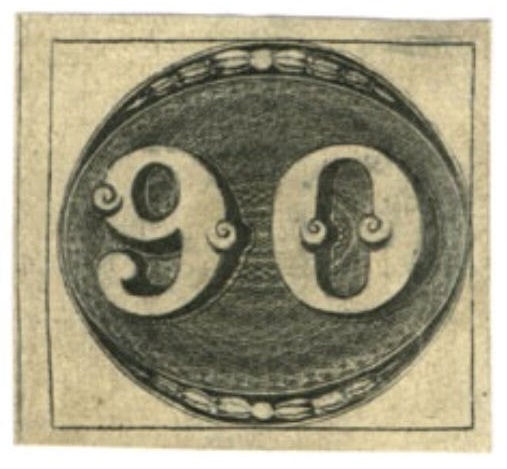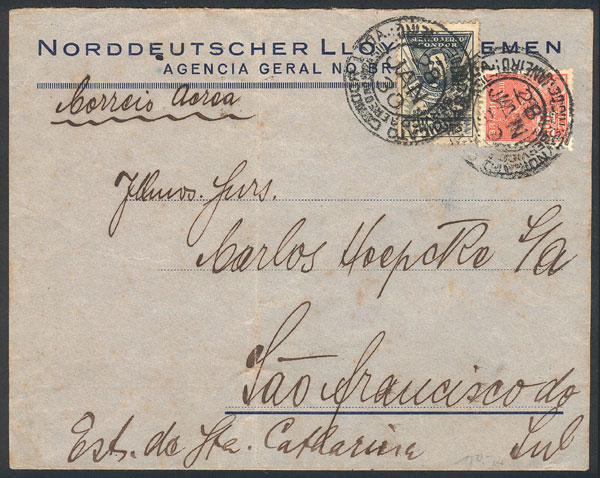 What can Be Done: Brazil is one of the most interesting philatelic areas. Because Brazilian philately is so vast, with over 3,500 collectible major numbers by Scott alone, specialists of Brazil often collect by issue or subspecialty. The first issues of Brazil are called the Bull’s Eyes because the numeral in ovals were thought to look like a bull’s eye (early philatelists seemed to feel that having a catchy moniker for what they collected gave their specialty a cachet—hence “bulls eyes”, “blackjacks”, “69s” etc.). The Bull’s Eyes are avidly sought out and are tough stamps to find. The next Brazilian issue (called the “goat’s eyes”) are among the scarcest stamps of Brazil. And the stamps of the last twenty tears of the nineteenth century are called the Dom Pedro’s because they picture the Emperor of Brazil, Dom Pedro. These stamps are fascinating and very appealing to collectors who like fancy cancels. Brazil largely used what Brazilians call “mute” cancellations to cancel stamps in this period. The vast numbers of designs and fancy ornaments in the cancels make for a very compelling Brazilian subspecialty.
What can Be Done: Brazil is one of the most interesting philatelic areas. Because Brazilian philately is so vast, with over 3,500 collectible major numbers by Scott alone, specialists of Brazil often collect by issue or subspecialty. The first issues of Brazil are called the Bull’s Eyes because the numeral in ovals were thought to look like a bull’s eye (early philatelists seemed to feel that having a catchy moniker for what they collected gave their specialty a cachet—hence “bulls eyes”, “blackjacks”, “69s” etc.). The Bull’s Eyes are avidly sought out and are tough stamps to find. The next Brazilian issue (called the “goat’s eyes”) are among the scarcest stamps of Brazil. And the stamps of the last twenty tears of the nineteenth century are called the Dom Pedro’s because they picture the Emperor of Brazil, Dom Pedro. These stamps are fascinating and very appealing to collectors who like fancy cancels. Brazil largely used what Brazilians call “mute” cancellations to cancel stamps in this period. The vast numbers of designs and fancy ornaments in the cancels make for a very compelling Brazilian subspecialty.
Once a collector gets to twentieth century Brazil, out comes the perf gauge. The Brazilian post office didn’t pay much attention to how they perforated their stamps, and differing perf types and compound perfs (compound perfs are when the perfs on the different sides of the stamps are different gauges) are legion, with many perf varieties being very rare. Further, large numbers of watermark varieties exist on all Brazilian stamps of the early twentieth century making additional varieties. After 1940, Brazilian philately becomes quite a bit easier, with fewer varieties. Because of the vast numbers of stamps issued, the large print orders, and relatively few native Brazilian collectors, most Brazilian stamps after 1940 are relatively inexpensive mint and downright common used. The airmails of Brazil have always been a fascinating specialty of their own. Brazil has a vast territory and, except for the coasts, has large, barely  inhabited expanses. There was a great need for airmail to connect the country. Further, Brazil encouraged semi-private airmail companies that issued their own airmail stamps. All in all, a collectors could start making a comprehensive specialized Brazil collection and spend a philatelic lifetime delving into interesting and challenging subspecialties of Brazilian stamps, all for prices that are very modest compared to the philately of, say, US or France.
inhabited expanses. There was a great need for airmail to connect the country. Further, Brazil encouraged semi-private airmail companies that issued their own airmail stamps. All in all, a collectors could start making a comprehensive specialized Brazil collection and spend a philatelic lifetime delving into interesting and challenging subspecialties of Brazilian stamps, all for prices that are very modest compared to the philately of, say, US or France.
Specialty Catalogs: The Scott catalog is really very good for Brazil, especially the Scott Classic catalog for issues to 1940. There are numerous specialty catalogs for things like the fancy cancels on the Dom Pedro issues. Especially interesting is the fact that many of the fancy or “mute” cancel designs were unique to each post office. Catalogs exist that not only price these cancels but identify the towns from which they came. The American Philatelic Research Library has a good section of Brazilian philatelic literature and catalogs.
Specialty Albums: The Scott specialty series for brazil is very good, and I’ve seen an impressive hingeless album produced by a Brazilian philatelic printer.
Expense: Probably the nicest aspect of specialized Brazilian philately is its cost. Except for a few multi-hundred dollar stamps, the vast majority of items can be had, mint or use, for under a few dollars each. Even very rare varieties are inexpensive, and specialists can spend a lifetime searching out scarce and desirable stamps for very modest prices. For nearly fifty years now, stamp writers have been predicting how prices for the stamps of Brazil would take off once the country achieved consistent economic growth. I know that Brazilians complain that their country still has severe economic problems, but by world standards Brazil is doing pretty well. But the mass of Brazilian collectors that were predicted by the previous generations of stamp writers has never materialized. The critical mass that used to be thought requisite for philatelic growth was high education levels and economic prosperity. It seems that more is needed before stamps become mainstream in a society. The Chinese collect avidly. The Brazilians do not.
Availability of Material: Brazilian stamps are plentiful, and specialists would do well to buy large, unsorted groups of Brazilian stamps to look through for varieties.
Overall Collection Grade: B+
